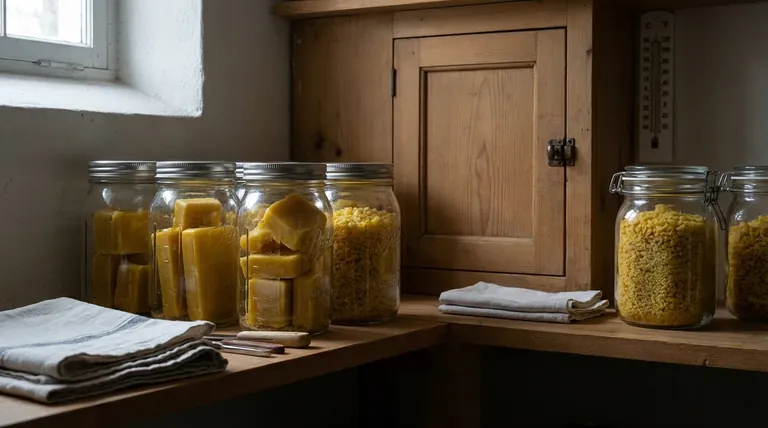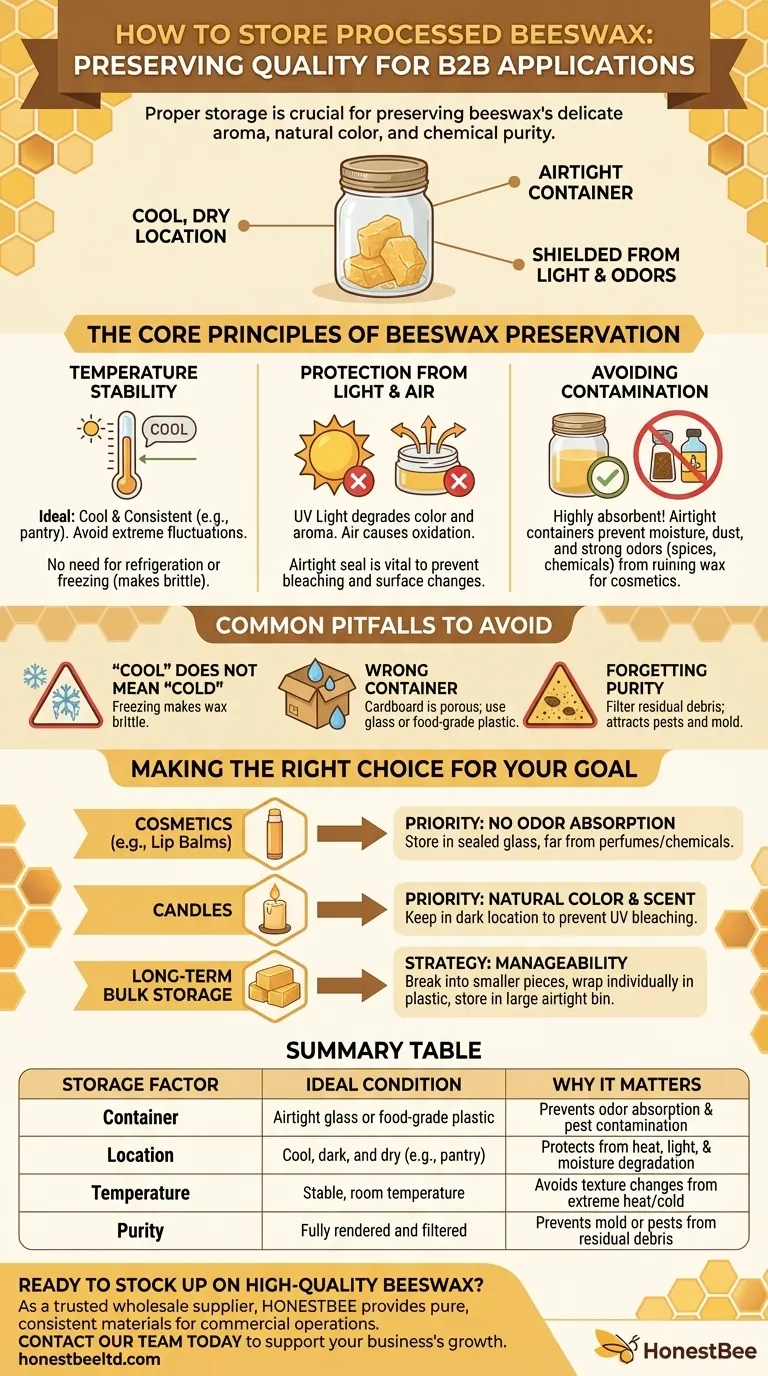Properly storing processed beeswax is straightforward and crucial for preserving its quality for future projects. To maintain its integrity, you must store it in an airtight container in a cool, dry location, shielded from direct sunlight and kept away from any strong odors or chemicals.
The goal of storing beeswax isn't just to prevent it from melting; it's to protect its delicate aroma, natural color, and chemical purity from degradation caused by heat, light, and environmental contaminants.

The Core Principles of Beeswax Preservation
Understanding why certain conditions are necessary will help you maintain the high quality of your processed wax. Beeswax is a stable natural product, but its valuable properties can be compromised without proper care.
Temperature Stability is Key
Beeswax has a relatively high melting point (around 144-147°F or 62-64°C), so room temperature is perfectly safe. However, the ideal storage location is cool and consistent, like a pantry, basement, or closet.
Extreme temperature fluctuations, even below the melting point, can affect the wax's texture over time.
Protection From Light and Air
Direct exposure to UV light from the sun will gradually degrade beeswax. This process can bleach its natural golden color and diminish its subtle, honey-like aroma.
Oxidation from open air can also slowly affect the surface of the wax, which is why an airtight seal is so important.
Avoiding Contamination
Beeswax is chemically stable, but it is highly absorbent when it comes to environmental factors like moisture and smells.
Airtight containers are non-negotiable. They prevent dust, debris, moisture, and pests from coming into contact with your wax.
Most importantly, the airtight seal protects the beeswax from absorbing ambient odors. Storing it near spices, cleaning chemicals, or mothballs will permanently infuse the wax with those scents, ruining it for use in cosmetics or candles.
Common Pitfalls to Avoid
Simple mistakes can compromise a perfectly good batch of beeswax. Being aware of these common errors ensures your wax remains pristine.
"Cool" Does Not Mean "Cold"
There is no need to refrigerate or freeze beeswax. While it won't harm the wax, extreme cold can make it very brittle and more difficult to cut, grate, or work with when you're ready to use it.
A cool, dark cupboard is superior to a refrigerator for maintaining usability.
Choosing the Wrong Container
Do not store beeswax in paper or cardboard boxes. These materials are porous and offer no protection from moisture or ambient odors, which the wax will readily absorb.
Always opt for glass jars with tight-fitting lids or high-quality, food-grade plastic containers.
Forgetting About Purity
The principle of avoiding contamination also applies to the wax itself. Ensure your beeswax is fully rendered and filtered before storage.
Any residual honey, propolis, or other hive debris left in the wax can attract pests or mold over long-term storage, even if the pure wax itself would not.
Making the Right Choice for Your Goal
Your storage strategy should align with how you plan to use the beeswax.
- If your primary focus is making cosmetics (lip balms, lotions): Your top priority is protecting the wax from absorbing any foreign odors. Store it in a sealed glass jar, far from any chemicals, perfumes, or fragrant items.
- If your primary focus is making candles: Preserving the natural color and subtle scent is paramount. Keep it in a dark location to prevent any UV bleaching from sunlight.
- If your primary focus is long-term bulk storage: Break large blocks into smaller, more manageable pieces. You can wrap these individually in plastic wrap before placing them together in a larger airtight bin or bucket to make future use easier.
By following these simple principles, you ensure your processed beeswax remains a pure and high-quality ingredient for years to come.
Summary Table:
| Storage Factor | Ideal Condition | Why It Matters |
|---|---|---|
| Container | Airtight glass or food-grade plastic | Prevents odor absorption and pest contamination |
| Location | Cool, dark, and dry (e.g., pantry, cupboard) | Protects from heat, light, and moisture degradation |
| Temperature | Stable, room temperature | Avoids texture changes from extreme heat or cold |
| Purity | Fully rendered and filtered before storage | Prevents mold or pests from residual hive debris |
Ready to stock up on high-quality beeswax and reliable beekeeping supplies?
As a trusted wholesale supplier to commercial apiaries and distributors, HONESTBEE provides the pure, consistent materials you need for successful large-scale operations. Whether you're crafting candles, cosmetics, or other bee products, proper storage starts with a superior product.
Contact our team today to discuss your supply needs and discover how our wholesale-focused solutions can support your business's growth and efficiency.
Visual Guide

Related Products
- Electric Beeswax Flat Sheet Machine with Operating Tray for Wax Processing
- Electric Flatting and Embossing Machine with Tray for Beekeeping
- Manual Beeswax Flat Sheet Machine for Beeswax Processing
- Professional Thermostatic Conical Honey Melter
- Honey Concentrating Vacuum Heating Thickening Machine Dehumidifier for Honey
People Also Ask
- What are the steps involved in preparing wax sheets for milling? Master Temperature Control for Perfect Foundation
- How does the beeswax flatting and embossing machine prepare the wax for processing? Achieve Perfectly Uniform Wax Sheets
- How does the machine flatten the beeswax? A Guide to Roller and Press Methods
- What are the advantages of using industrial wax melters for beeswax? Achieve Scalable, Safe, and Consistent Production
- How do worker bees produce beeswax? A Guide to the Hive's Manufacturing Process



















